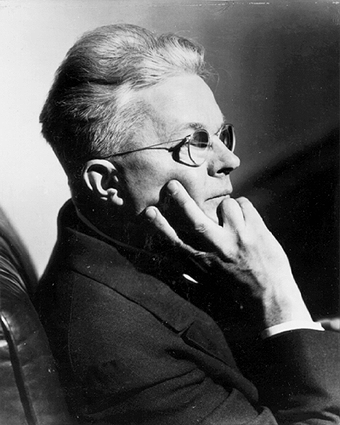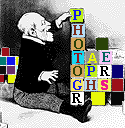

Roy Stryker was born November 5, 1893 in Great Bend, Kansas. He grew up on a farm in Montrose, Colorado where his "populist" father instilled in him a great respect for the land and the people who worked it. After serving in the infantry in World War I, Stryker went on to study economics at Columbia University. After graduating in 1924, he remained to teach the subject at the invitation of his mentor, Rexford Tugwell. The two men collaborated on producing a book entitled, "American Economic Life," which made extensive use of photographs to complement the text. Stryker would also illustrate lectures using his great collection of images. These photographs became a powerful teaching tool that infused life into the economic theories that Stryker taught his students. Little did anyone know then that Roy Stryker would go on to produce a photographic record of the United States undergoing a period of profound change, which would lead the nation from a rural culture into an urban, technological one.
As a member of Franklin Roosevelt's Brains Trust, Rexford Tugwell organized the Resettlement Administration to address the mounting economic problems faced by people living in America's heartland. This agency later became known as the Farm Security Administration, and it was to provide "rehabilitation loans and resettlement opportunities to farmers impoverished by drought, soil erosion, and the effects of the Great Depression." In 1935, Stryker followed his mentor's path to Washington, D.C. and was appointed head of the FSA's Historical Section, where he would direct the photographic documentation of the agency's activities. Over the ensuing years, Stryker would attract and assign some of America's most renowned photographers to document the effects of the Great Depression on people in the hardest hit areas of the country. Although Stryker was not a photographer himself, he promoted using the camera as a tool to document society. His work, especially in the early years of the FSA, was to enhance the public's perception of the federal aid programs for the destitute. Stryker led the project from 1935 to 1943 and was responsible for launching the careers of photographers such as Dorothea Lange, Walker Evans and Gordon Parks, among others, and for building an unmatched photographic legacy of life in America.
In addition to attracting top-notch photographers to work for him, Stryker had a talent for getting the best out of each one. Even though he did not concern himself with the mechanics of wielding a camera, Stryker developed into a great teacher who could inspire those who came to work for him. Before sending his photographers out into the field, Stryker made sure they were well-informed about their assigned area, its people, economy and even its politics. He often gave his photographers books to read and would encourage them to look at assignments in new and different ways. Stryker felt that an educated, sensitive photographer would produce images that "would mirror both his understanding and his compassion."
In the effort to get the government's message of reformation across to the American people, Stryker worked "to establish an extensive network of contacts among book and magazine publishers that ensured that FSA photographs, which came to number 270,000 were widely used." The new picture magazines, Life and Look, included essays on the FSA project, and the photographs also found their way into museums and galleries around the country. They even appeared at the World's Fair in 1939 in New York City. In 1962, an exhibit of several hundred photographs from the FSA files was mounted at the Museum of Modern Art in New York City. Museum director, Edward Steichen, selected the images and dedicated the exhibit, entitled "The Bitter Years: 1935-1941," to Roy Stryker and all the FSA photographers.
With the onset of World War II, the photographic unit was taken over by the Office of War Information, and its mission turned to reflecting more positive images of the country in order to boost morale on the home front. In 1943, under mounting bureaucratic criticism of the FSA as a waster of government funds, Congress ruled that the rural assistance programs be reorganized and that the FSA be disbanded. The New Deal experiment to aid rural farmers had come to an abrupt end. Stryker's historical section was transformed into a photographic agency for the OWI, and his team of photographers began to disband. Although the 130,000 FSA photographs were being filed and cataloged for future use, there was a real threat that enemies of the organization wanted them destroyed. In order to facilitate a safe and orderly transfer of the collection to the Library of Congress, Stryker sought approval for such a move from the office of President Roosevelt himself. During this period of instability, Stryker was approached by Standard Oil of New Jersey to organize a documentation project for the purpose of improving the company's public image. After confirming that the FSA photographs were safe within the walls of the Library of Congress, Stryker resigned and took several of his remaining FSA photographers along to his next project.
Stryker's work at Standard Oil of New Jersey lasted from 1943 to 1950 and was the "largest photographic documentation project ever undertaken in America by anyone other than the federal government." Although he initially had some misgivings about working for a large corporation with such a tarnished reputation, and despite photographer Harold Corsini's description of him as a Depression-era "apostle of the downtrodden," Stryker finally accepted the offer. The SO project required the documentation of the company's operations in the field and other topics that related somehow to the oil industry. By the time the project was completed, some 67,000 photographs had been produced.
In selecting photographers for this project, Stryker sought those who possessed an "insatiable curiosity, the kind that can get to the core of an assignment, the kind that can comprehend what a truck driver, or a farmer, or a driller, or a housewife thinks and feels and translate those thoughts and feelings into pictures that can be similarly comprehended by anyone." Photographers on the SO project included, among others: Berenice Abbott, Gordon Parks and Todd Webb; as well as Esther Bubley, Harold Corsini, Russell Lee, Arnold Eagle, Elliott Erwitt and Sol Libsohn, who would later follow Stryker to his next project in Pittsburgh. After suggesting topics he wanted documented, Stryker gave his photographers the freedom to pursue their individual approaches to their subjects. As with all his projects though, Stryker was adamant that his staff understand their subjects and their context before going out on an assignment.
Charles Rotkin, who worked on the SO project as an aerial photographer, described Stryker as being "an archivist. He didn't give a damn about a picture at the time it was made. He was interested in what it would mean twenty years later... He was saving pictures for a record of the past." The photographs produced by the SO project were published in newspapers and magazines across the country. They were used to illustrate textbooks and were exhibited in museums and galleries as well. As opposed to the emotionally-charged FSA photographs that depicted the ravaging effects of the Depression, the SO images recorded the elements of society that prospered from oil production. Corporate budget-trimming in the late 1940s threatened continuation of the SO project. The collection would eventually be transferred to the Photographic Archives at the University of Louisville. Stryker thus was free to accept an offer to direct the Pittsburgh Photographic Library.
In order to document the renaissance of the "Smoky City" into a modern urban industrial center, the city's corporate and educational leaders sought out Stryker's help in directing such a project. In a letter addressed to an administrator at Pittsburgh's Carnegie Museum in late 1949, Roy Stryker detailed his ideas for implementing a photographic library: "All materials from all sources would be integrated into an active Photographic Library -- the heart of the project... It is a place where material is coordinated, where it is so classified and arranged as to be easily available to those who wish to use it... Such a library has certain dynamism -- it calls for material and is a constant inspiration to photographers and users of pictures." Commenced in July 1950 at the University of Pittsburgh, the PPL would become the nerve center for what has been described as "the most complete photographic documentation ever achieved by any American community." Although Stryker resigned from the project in 1952, the PPL continued in operation for several more years before being dissolved. Stryker was involved in negotiating the transfer of the roughly 18,000 photographs to a proper repository. In 1960, the collection was transferred to the Carnegie Library of Pittsburgh.
After leaving the PPL, Stryker directed a documentation project at Jones & Laughlin Steel Corporation. Thereafter, he accepted consulting jobs on occasion and conducted seminars on photo-journalism at the University of Missouri. Stryker eventually returned to the west in the 1960s. He died in Grand Junction, Colorado on September 27, 1975.
Not only did Roy Stryker orchestrate an unmatched documentation of a crucial period in American history, but he also helped transform how we look at photographs. Stryker's photographers have taught us "that a picture could be beautiful and still possess a social conscience." Most of the men and women who worked for Roy Stryker continued their photographic careers and some, notably Berenice Abbott, Gordon Parks, Dorothea Lange and Walker Evans, would achieve great fame. Many of them would carry his words of advise with them. As photographer Carl Mydans relates, "In all the years since I left him, when making pictures I often hear him say, 'Now what are you doing that for? Why are you making that picture?'." Roy Stryker's teaching and his passion for photo-journalism continue to make a profound impact among documentary photographers today.
pd
